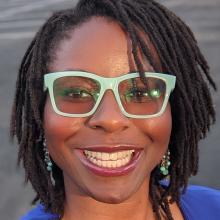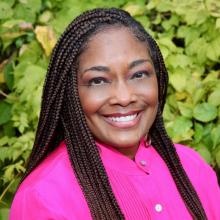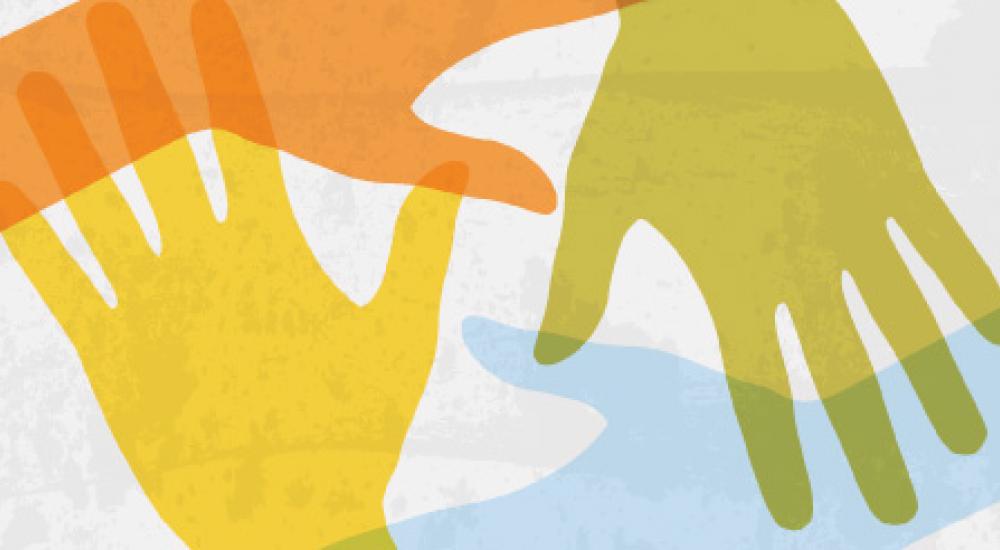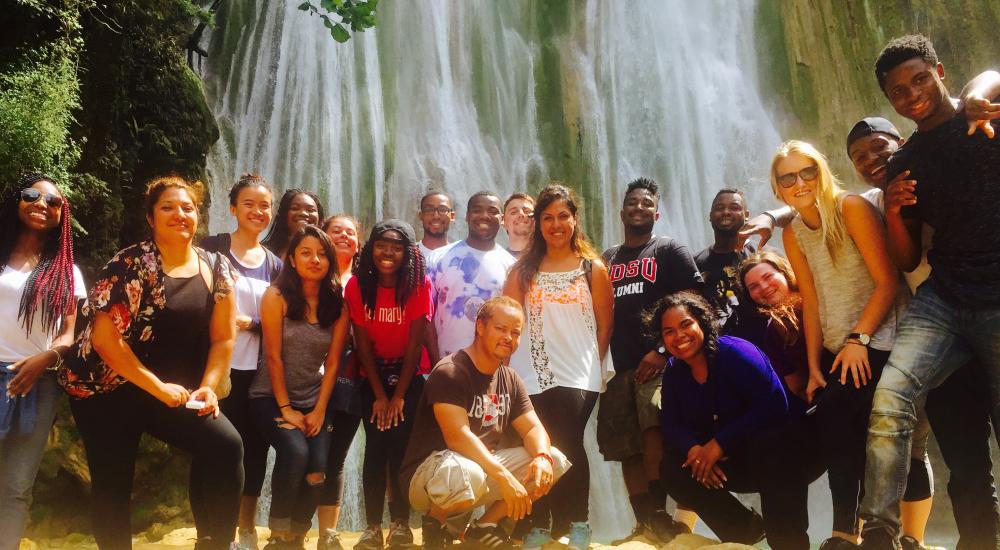Sea Change: A Conversation About Diversity, Equity, and Inclusion Within International Education

Efforts to diversify the field of international education have accelerated over the past few years, and Ogonna Owu, MA, and Gretchen Cook-Anderson, MA, have had a front-row seat to the changes and challenges.
Owu has been a study abroad adviser for the past 4 years at Towson University, where she specializes in program and project management of diversity, equity, and inclusion initiatives, among other duties. She is a fellow of NAFSA’s inaugural RISE (Representation, Inclusion, Support, and Empowerment) program, which will conclude at the end of 2021. Owu has worked at Maryland-based higher education institutions for almost 10 years.
Cook-Anderson is the inaugural executive director of Ignite, a nonprofit that aims to cultivate greater diversity, equity, and inclusive culture across the biotechnology industry in Boston and beyond.
Prior to making the jump to biotechnology from international education, Cook-Anderson was at IES Abroad for 10 years, where she was associate vice president; assistant to the president for diversity, equity, inclusion, and antiracism; and director of diversity recruiting and advising.
In 2021, Cook-Anderson was honored with the inaugural NAFSA Award for Impact in Diversity, Equity, and Inclusion, which recognizes a NAFSA member who has shown sustained commitment to this mission by advocating for the interests of underrepresented populations.
Editor’s note: This interview has been edited and condensed. Listen to the full interview on the International Educator podcast below.
Ogonna Owu: Over the course of your career, what positive changes have you seen in the field when it comes to diversity, equity, and inclusion?
Gretchen Cook-Anderson: I have seen a sea change just in the last 10-1/2 years that I have been working in the field. I also did a stint in this field in the 1990s, when I was a deputy director at the Howard University Ralph J. Bunche International Affairs Center. My first NAFSA conference, I believe, was in 1996 or something like that. Even reflecting back that far, in the 1990s, matters of diversity, equity, inclusion, and antiracism within this field were really not discussed.
I think the thought was, our professionals were to work with all students and support all students, but there was far less intentionality around creating messaging and providing support that was truly equitable, that truly provided an expansion of access for students who needed that in order to be able to study abroad. The thought during that period of time was that if a student wanted to study abroad, they would step forward. They would show up in their study abroad office, and they would work with the staff to make it happen.
I don’t think there was a realization in the field, which was kind of a budding field in the 1990s, that there were entire populations of students on our campuses across the country who might have been interested in study abroad, but we weren’t reaching them. We weren’t reaching them where they were, pulling them into the experience, providing information, sharing stories of other students who they could identify with. We weren’t doing that. We were just making assumptions that if a student did not show up in the study abroad office, they weren’t interested.
There was also an assumption that there were barriers in the way for some students but that there wasn’t that much we could do—that we were not empowered as a field and as professionals in the field to actually help those students to hop right over those barriers, to push through those barriers. I don’t think we felt empowered to really be able to help them make the changes they needed in order to make study abroad possible.
We were just making assumptions that if a student did not show up in the study abroad office, they weren’t interested. ... I don’t think we felt empowered to really be able to help them make the changes they needed in order to make study abroad possible.
When I look at the arc since the 1990s, I think about what’s changed. Around the time I came aboard at IES Abroad, Diversity Abroad, the organization many of us are familiar with, also came into being. And the field began slowly—and it started slowly—vocalizing and talking about why are there entire swaths of students, entire populations, who are not choosing this high-impact experience. We started questioning that and really wondering why were they not showing up, and then asking ourselves what our responsibility was as professionals in the field to be able to create a pathway for many students who traditionally had not studied abroad. It was really interesting to walk into the field at that time—this would have been in 2011—to start talking about these kinds of topics.
I do have to say that in the beginning, it was almost like crickets chirping. I would go to conferences and I’m talking about these things. And I think a lot of people were wondering, well, why is this necessary? Why do we need to be talking about access? Why do we need to be talking about the importance of a more diverse group of students from the United States going abroad, out into the world? Why is that important? Why is it important that so many students are missing out on an extremely valuable experience that could also be helpful to them in their own pathway to upward mobility?
We began asking those questions, and I teamed with Andrew Gordon—I think he and I were conspiring in those days to really keep nudging and pushing and prodding the field to make this important, and to make it important on behalf of the students. So I have seen the sea change, like I said, from about the mid-1990s.
[From] my Howard University days, when no one was talking about any of this, to the 2011 period, when we had whisperings and people began to latch on to the idea of the importance of these themes, to now, when issues around social justice and racial equity and identity and one’s identity in the world—these issues are really in the forefront in our culture here in the United States, but also around the world. We know that’s due to a number of different reasons and incidents that have happened in our culture and elsewhere that have been linchpins for conversation and for change.
So I have definitely seen change. I have seen change in the actual raw numbers of students who are choosing to study abroad now from different ethnic and racial backgrounds. Students with disabilities and varying abilities, students with mental health histories, students from nontraditional age [groups], students who served in the military who are veterans—it’s been really wonderful for these students to understand increasingly that this is an experience for them. It is something that can be life-changing for them, too, not just the more traditional student over the decades, who was more affluent. It was traditionally White women going abroad. It’s really been wonderful to see the composition of the students studying abroad from the United States change just in the last 10 years, particularly right before the pandemic hit.
You touched on this a little bit in your response, but could you tell us more about which areas still need improvement? And how do you think those areas can be improved?
We focused a lot in the field on the composition of the students going abroad. I think there’s some momentum there now, or at least I hope there is. Most people wouldn’t realize this, but interestingly enough, as study abroad is ramping back up, the composition of the students who are choosing to study abroad [with IES Abroad] is almost identical to what it was just before the pandemic hit.
It’s been remarkable to see that, because we were concerned that a lot of our students of color [or] students coming from lower socioeconomic backgrounds, whose home lives may have been deeply affected by COVID-19 and whose economic realities have been affected a lot more than some of their peers, we thought those students might not come back to us—that there might need to be even more work done to attract them back to study abroad. But we have found that, in reality, they are choosing to go in the same raw numbers and percentages that they were choosing to go before. That’s been really heartwarming to see. I don’t know if that’s the case across the entire field, but that’s what we’ve seen.
Where I feel we need the most work is actually in the composition of our professionals in the field. I think the field itself needs to work harder to attract more professionals of color, to attract more professionals from all kinds of underrepresented identities. We need to do more work around that. I think it’s possible. When I see what we’ve been able to do at IES Abroad and working on the composition of our workforce, it’s been with targeted intention. You have to say what it is you’re going to do, then you have to put into place the mechanisms by which to make it happen, if indeed you believe it’s important that the field be just as diverse as the students who we’re sending abroad.
I think the field itself needs to work harder to attract more professionals of color, to attract more professionals from all kinds of underrepresented identities.
I do think the field itself is going through a reckoning, not only because of the pandemic, but it’s gone through a reckoning around racial diversity and racial equity within the professional field. I hope we will see more change as the field ramps back up, because unfortunately we lost a lot of people last year. Because of that, there is a real opportunity right now for colleges and universities, for study abroad and academic providers, and any of the folks within the industry that touch education abroad—like NAFSA and IIE, for example—there is a real chance right now to make that change as those organizations begin to ramp back up professionally.
As far as diversifying the profession of international education, human resources and hiring practices are a starting point for many international offices. What are some successful practices for employers to attract and retain staff from those underrepresented backgrounds you’ve mentioned?
From the retention standpoint, first, there has to be intentionality. Those offices need to understand who they do not have within their ranks, and they have to make a commitment—a long-term, not just a short-term, one-off commitment, but a long-term commitment to diversifying their workforce. However many people they have in their offices, whether it’s 2 professionals or it’s 20, they have to make a commitment to it and prioritize it, number one.
Then, they have to put into place a means of really looking at how they can diversify their pools of candidates. When they have a position that comes available, or they get new funding from their institution to onboard a new role, they need to be looking with intentionality around setting this hiring situation up so [they] will attract a more diverse pool of candidates than [they] typically have.
There are all kinds of ways to do that. But once we have that diverse pool of candidates for a particular position, how do we, as hiring managers, work to eliminate our own personal biases that we may be using in selecting folks for these positions? There’s a lot of questioning in the field around what is professionalism in our field, and what does professional mean? Who is a good fit for any particular office?
There is a need to try to explore that and to shake it up a little bit—to really think about if you want to attract students from various different identities as an institution, then sometimes you’ve got to shake it up. Who’s actually doing the outreach to those students, how they are speaking and messaging to those students, and what are their own experiences that can be brought to bear, to inspire those students, to try something that perhaps they haven’t tried.
What does someone who would be a professional in this environment look like, how do they talk, what do they think, how do they think, how do they strategize? What ideas do they bring to the table that perhaps we have not had? It’s that diversity of thought, perspective, story, and background that is actually going to make these offices so much more enriched, but also so much more diverse and inclusive.
All hiring managers need to be thinking about that instead of thinking about, I’m going to hire somebody who reminds me of myself, or I’m going to hire someone who seems like they’re a good fit from a very traditional perspective. I think we’ve got to shake that up and think about, what does someone who would be a professional in this environment look like, how do they talk, what do they think, how do they think, how do they strategize? What ideas do they bring to the table that perhaps we have not had? It’s that diversity of thought, perspective, story, and background that is actually going to make these offices so much more enriched, but also so much more diverse and inclusive.
The second part of the question about inclusion is that [inclusion also] has to be intentional. You have to have leadership in these offices, again, who value both diversity and an inclusive workplace. There are a number of different ways to cultivate that. But we have to have leaders in these offices who, if they don’t understand how to foster inclusion, [realize] that they themselves need to do some work around that, perhaps some professional development of their own, so they can get some tools and tips on how to do that. Attending the conferences we have in the field that NAFSA hosts, that the Forum on Education Abroad and Diversity Abroad and others host, that are true professional development that can help give people more tools they can use to create a more inclusive workforce, which is then going to help them hold on to people.
When I think about my own experience, the fact that I am about to embark on something new—it’s been hard. It’s hard to leave, but that’s what you want. You want an environment that is so warm, so wonderful, and so enriching, and [that] provides the professional challenges, learning, and growth, but also a place where [staff] feel they truly belong, where they can contribute, where they’re heard and celebrated and embraced. You want all of that, ideally, in a workplace in our field, so that it makes it hard for people like me to actually take a step outside of the boundaries of that work to do something else. You want to make it hard.
Thank you for highlighting what some of those barriers are for getting these practices off the ground, practices that are crucial to recruiting and retaining underrepresented, diverse professionals in the field.
There’s unconscious bias, and that’s something that happens across every industry and every field when it comes to hiring. That’s why, when you look across the scope of employment in America, and especially leadership in America, you still don’t see the diversity that we should [have], at the point we are [at] in our society. Unconscious bias drives a lot of that. In our field, we’ve got that going on as well. People need to really think about what their biases are and why they are, and why they don’t see a more diverse composition within the folks they work with in their offices.
When I first started some years back, I had the experience that most education abroad offices were looking for: They wanted you to have study abroad experience. I studied in Argentina when I was an undergrad, and I taught English in South Korea for a year. I speak Spanish fluently, and I speak some Korean. I’ve had multiple opportunities to have the international experiences that offices look for. I’ve done academic advising as a peer when I was an undergraduate student, which is helpful for study abroad–related advising. [As I was looking for jobs,] it was mind boggling when I would see a lot of the job descriptions would say they would require you to have a bachelor’s degree, but the preference is a master’s.
I wonder if we’re losing out on some potential rock stars for the field, not just study abroad, but in other aspects of international education, if those things could be remedied. And how do pay equity and transparency about pay equity play into the conversation about diversifying the field?
Yes, equity is important, [as is] demystifying the pay scale in the field, whether you’re at a college or university, an academic study abroad provider, or other organizations like NAFSA that support the field. What I hear from a lot of people over time is that it seems like there’s a closed door as to what people make. Am I truly valued in my workplace based on what I make, if I’m aware that someone else who is doing similar work has an elevated pay? There is a kind of wondering, well, why is that, if we’re doing more or less the same kind of work, and even if length of service is fairly similar. That has been an issue in the field, and it continues to be.
I do like the fact that I see more folks in the field at leadership levels having conversations around it, and there are efforts to try to make pay in the field a bit more transparent. This field is not unique in that. A lot of industries and fields are [similar]. I have always found it quite interesting that there’s not more transparency, but as issues around transparency in general have come to the forefront in recent years across all industries, there’s been a push and a demand for more transparency in general from leadership of organizations. As that push continues, hopefully we’ll see more transparency in pay.
Because the field has a lot of women and women in leadership, I don’t know that it’s so much a gender pay equity issue in this field. I do feel there are some racial equity issues, based on folks who I’ve talked to over time who have maybe found out what a colleague makes and wondered, well, as a Black male or as a Black woman, or as a Latina, in this industry, why am I making less than this person? Does it mean that I’m not valued as much in this workplace? That my experiences, my skill sets, and my talents are not valued as much in this workplace?
I know people who have left [jobs] for that reason, who have felt that their efforts and their hard work were not rewarded with raises and promotions at the same speed as some of their peers and have watched peers move ahead when they have struggled to.
You mentioned the importance of having more diverse or underrepresented professionals in the field as it relates to student participation in study abroad. Why is diversifying the field of professionals important for getting a more diverse student population to participate in study abroad?
Number one, we should just be a more diverse professional field, just for the sake of that—for the sake of broadening opportunities to more people who may take an interest in working with students to send them abroad. America, as a country, is a diverse nation. I’m a big believer that our workforce, no matter what industry, should look like our country and should look like the people who make up this culture.
But I also think students like to see themselves reflected, their lived experiences reflected, in the people with whom they engage—especially students of color who continue to be nontraditional when it comes to study abroad and whose numbers are still lower [in study abroad] than they are in our culture. If you really want more of these students who historically have not chosen to study abroad during college, if we want more of them to go, it’s [important] that they see people who look like themselves, who share their experiences, and who can talk about how amazing and transformative the opportunity is.
We should just be a more diverse professional field, just for the sake of that—for the sake of broadening opportunities to more people who may take an interest in working with students to send them abroad.
I’m a marketing executive, and I’ve done a lot of marketing intelligence and research about students in study abroad: why a student will choose to go, why a student might choose not to go. One of the things we know from a marketing perspective in general is that Black students are more likely to buy into a product, a service, or an experience if they feel that they are in mind, uniquely, when the outreach is happening. Part of making that happen is to also have professionals in the field who reflect who they are, who can tell their stories, and who can message to them in ways that are important to them and that appeal to them uniquely. That goes across the board [to include] all of our students of diverse identities.
One message about the importance of education abroad is not always enough. We have to parse out our messaging a bit when we are trying to reach different students, because different students have different motivations, different interests, different concerns, and different needs. We need to give that a lot of critical thought. But we also need to have professionals who reflect those young people so they can see themselves in the experience. •
About International Educator
International Educator is NAFSA’s flagship publication and has been published continually since 1990. As a record of the association and the field of international education, IE includes articles on a variety of topics, trends, and issues facing NAFSA members and their work.
From in-depth features to interviews with thought leaders and columns tailored to NAFSA’s knowledge communities, IE provides must-read context and analysis to those working around the globe to advance international education and exchange.
About NAFSA
NAFSA: Association of International Educators is the world's largest nonprofit association dedicated to international education and exchange. NAFSA serves the needs of more than 10,000 members and international educators worldwide at more than 3,500 institutions, in over 150 countries.
NAFSA membership provides you with unmatched access to best-in-class programs, critical updates, and resources to professionalize your practice. Members gain unrivaled opportunities to partner with experienced international education leaders.
















